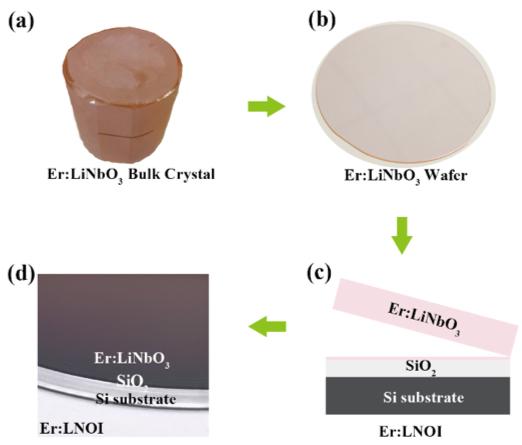
Credit: @SCIENCE CHINA PRESS
As a complement to silicon-based photonic chips, lithium niobate thin film (LNOI) has become a research hotspot in the field of optoelectronic integration due to its outstanding nonlinear, electro-optic, acousto-optic, piezoelectric and other physical properties. On-chip integrated frequency multipliers, modulators, and filters based on lithium niobate thin films have been developed, but the on-chip integrated communication band light source is still in urgent need of development. Recently, researchers from Shanghai Jiao Tong University publicly reported for the first time that they designed, fabricated, and realized the laser output of a microcavity on a lithium niobate chip on a self-developed erbium-doped LNOI.
The whispering gallery mode microdisk resonator has a small size and high quality factor. By selecting a suitable pump source and designing and fabricating the LNOI microdisk carefully, the integrated lithium niobate on-chip C-band lasers output has been achieved. The research results were entitled “On-chip Erbium-doped lithium niobate microcavity laser” and published on October 30, 2020, in SCIENCE CHINA Physics, Mechanics & Astronomy as the cover article of Volume 64, Issue 3. Professors Yuping Chen and Xianfeng Chen from Shanghai Jiao Tong University are the corresponding authors.
As we all know, the energy level system of rare earth erbium ions can meet the conditions of laser radiation in the communication band. Previously, lasers and amplifiers doped with rare-earth ions could only be effectively realized and applied in optical fibers and silica films. So far, there are only a few research reports on erbium-doped lithium niobate thin films, and the fluorescence output is obtainable only at low doping concentrations but with poor uniformity by ion implantation and thermal diffusion methods. When discovering these problems over the past two years, researchers abandoned ion implantation and thermal diffusion methods, and chose to dope erbium ions during the growth of lithium niobate crystals, aiming to solve the problems of erbium-doped lithium niobate concentration and uniformity. As a result, lithium niobate thin films were made via the smart-cut process, as shown in Figure 1. These processes were completed through cooperation with Shanghai Daheng Optical and Fine Mechanics Co., Ltd. and Jinan Jingzheng Electronics Co., Ltd.. The erbium-doped lithium niobate film prepared by this method has a uniform distribution of erbium ions and meets the development requirements of on-chip lasers.
Subsequently, the researchers used a focused ion beam (FIB) etching method to fabricate a microdisk resonator on a 600 nm thick Z-cut erbium-doped lithium niobate film. The pump light in 980 nm and 1480 nm band was used and coupled through a tapered fiber. The laser output in the communication band was obvious under these two pumps (as shown in Figures 2 and 3).
This research result realizes the integrated light source in the communication band of the lithium niobate chip, which is of great significance for the efficient integration of the on-chip light source and various functional devices of the lithium niobate thin film material in the future.
###
This research was funded by the National Key R & D Program of China (Grant Nos. 2019YFB2203500?and 2017YFA0303700), National Natural Science Foundation of China (Grant No. 91950107), Foundation for Development of Science and Technology of Shanghai (Grant No. 17JC1400400).
See the article:
Yi’an Liu, Xiongshuo Yan, Jiangwei Wu, Bing Zhu, Yuping Chen, and Xianfeng Chen, On-chip erbium-doped lithium niobate microcavity laser, Sci. China-Phys. Mech. Astron. 64, 234262 (2021), https:/
https:/
Media Contact
Yuping Chen
[email protected]
Related Journal Article
http://dx.




